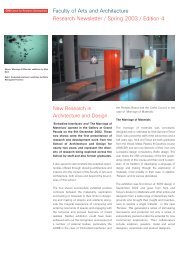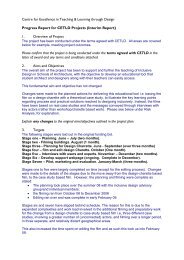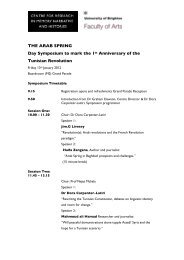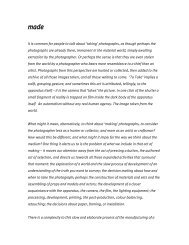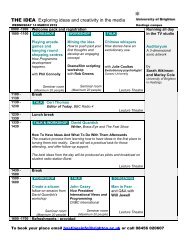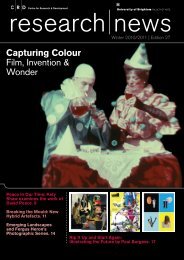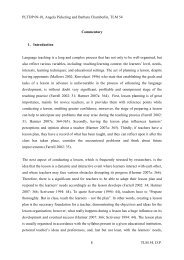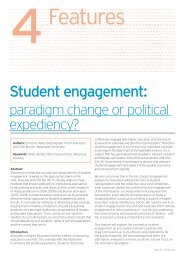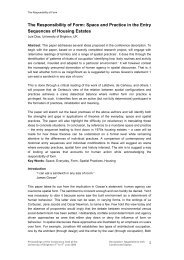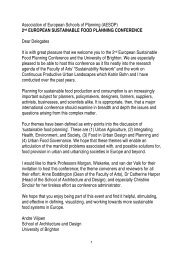Ro Spankie & Anna Araujo 'Patterns of Occupation' - University of ...
Ro Spankie & Anna Araujo 'Patterns of Occupation' - University of ...
Ro Spankie & Anna Araujo 'Patterns of Occupation' - University of ...
You also want an ePaper? Increase the reach of your titles
YUMPU automatically turns print PDFs into web optimized ePapers that Google loves.
Patterns <strong>of</strong> Occupation<br />
Patterns <strong>of</strong> Occupation<br />
<strong>Ro</strong> <strong>Spankie</strong>, <strong>University</strong> <strong>of</strong> Westminster, UK<br />
Dr <strong>Anna</strong> <strong>Araujo</strong>, Bartlett School <strong>of</strong> Architecture, London, UK<br />
Abstract:<br />
‘Home is represented not by a house, but by a practice or set <strong>of</strong> practices.<br />
Everyone has his own’. 1<br />
This paper proposes that interior space is not a series <strong>of</strong> still lives but rather it gains meaning<br />
and significance through its occupation. This shifts the focus from the ‘object’, the architecture,<br />
to the ‘subject’, the occupant and places emphasis on what we have termed ‘patterns <strong>of</strong><br />
occupation’, constructed through acts <strong>of</strong> ritual, arrangement, order and repetition. Suggesting<br />
that occupation precedes the physical enclosure, the paper will go on to argue that interior<br />
space is defined by the user’s impulse to arrange and order their space, rather than by the<br />
conscious actions <strong>of</strong> the designer. This impulse for order can, however, be at odds with the<br />
inevitable disorder created through the act <strong>of</strong> occupation, thereby establishing a cyclical,<br />
dialectical logic. We claim this dialectic or tension is a creative drive in terms <strong>of</strong> how we<br />
occupy and construct space as it intriguingly echoes the workings <strong>of</strong> the human psyche.<br />
The paper begins by examining the notions <strong>of</strong> ritual, arrangement, order and repetition and<br />
then considers how these might be applied as analytical tools to the definition <strong>of</strong> an interior<br />
space. Then, looking in particular at how Sigmund Freud organized his own rooms, we<br />
suggest that his psychoanalytical enterprise is entwined with the ordering and arrangement <strong>of</strong><br />
interiority, physical as well as psychological, and that this ordering and arrangement are<br />
inherent to the practice <strong>of</strong> occupation. In sum, through ritual, arrangement, order and<br />
repetition, Freud’s interior came to delineate a topology <strong>of</strong> the inner self, and as such it may be<br />
read as a paradigm both for psychoanalysis and for interior design disciplines.<br />
Ritual<br />
Fig. 1. Dancing Space, Sion Manning School, by Curl la Tourelle.<br />
‘Before Daedalus made Ariadne’s dancing floor … there was no thought given to the<br />
place for the dance … the measure <strong>of</strong> the dancing floor was the measure <strong>of</strong> the dance<br />
itself. The place appeared with the dance and disappeared when the dance was over.<br />
Proceedings <strong>of</strong> the Conference held at the Occupation: Negotiations with<br />
<strong>University</strong> <strong>of</strong> Brighton 2 nd to 4 th July 2009 Constructed Space<br />
1
Patterns <strong>of</strong> Occupation<br />
Its independent status was not even an issue. When choros first becomes dancing<br />
place, it does not cease to be dance, however … Homer says that on Achilles’ shield<br />
Hephaestus poikille (wove) a dancing floor like the one Daedalus made for Ariadne, but<br />
he does not say that the dancing floor was made first and that only then did the dance<br />
take place. In fact, he says nothing about the dancing floor at all; the description is<br />
devoted entirely to the dance. The dancing floor seems to emerge with the dancing <strong>of</strong><br />
the youths and maidens …’. 2<br />
The quote above describes an interior space that is created by occupation rather than physical<br />
enclosure. In the choros, interiority is produced by the rhythm <strong>of</strong> the dance, which both<br />
precedes and defines the physical construction <strong>of</strong> the dancing floor. Choros is the masculine<br />
<strong>of</strong> chora, both having been in Greek culture conventionally used to designate what we today<br />
define as interior space. As McEwen explains, the masculine choros generally denoted ‘a<br />
space that is somewhat more defined’, either in terms <strong>of</strong> dimension, or in terms <strong>of</strong> use, while<br />
the feminine chora usually defined a ‘territory made to appear through a continual remaking ...<br />
<strong>of</strong> its encompassing surface’. 3<br />
Central to the notions <strong>of</strong> both choros and chora is the idea <strong>of</strong> ritual, <strong>of</strong> a pattern <strong>of</strong> occupation<br />
that is culturally defined and that depends upon a logic <strong>of</strong> reiteration – repetition, remaking. If<br />
the creation <strong>of</strong> interior space is determined by ritual, then it is the user, rather than the<br />
designer, that produces it. This production, rather than being the result <strong>of</strong> a definitive act (<strong>of</strong><br />
construction), is reliant on an ever-recurring pattern <strong>of</strong> occupation. As stated in McEwen’s<br />
quote, where there is no dance, there is no dancing floor either: the space <strong>of</strong> the dance relies<br />
on the choreographic workings <strong>of</strong> the dancers to emerge and reemerge. In a similar guise, we<br />
want to argue that where there is no occupation there is no interior space as such.<br />
Arrangement and Order<br />
Fig. 2. Drawer Sort, by Lucy Leonard.<br />
As already suggested, choros and chora relate to the word choreography, which means ‘the<br />
art <strong>of</strong> arranging how dancers should move during a performance’. 4 Inherent to every<br />
Proceedings <strong>of</strong> the Conference held at the Occupation: Negotiations with<br />
<strong>University</strong> <strong>of</strong> Brighton 2 nd to 4 th July 2009 Constructed Space<br />
2
Patterns <strong>of</strong> Occupation<br />
choreography is the notion <strong>of</strong> arrangement and order. Order in Greek translates as kosmos,<br />
which, as McEwen explains, can be thought <strong>of</strong> as ‘a mutable rhythm governing a pattern <strong>of</strong><br />
movement’, as a ‘template to be traced or copied’ or as a standard <strong>of</strong> rightness. 5 Kosmos is<br />
also the origin <strong>of</strong> the word ‘cosmetic’, meaning adornment – feminine adornment, especially.<br />
In the book Kosmos: Essays in Order, Conflict and Community in Classical Athens, Paul<br />
Cartledge addresses this multiple signification <strong>of</strong> kosmos, explaining that, in ancient Greece,<br />
because ‘order was considered beautiful, kosmos came next to mean adornment, as in our<br />
cosmetic’. 6 Kosmos was a far-ranging concept. It related to functions as diverse as that <strong>of</strong><br />
embellishing the body, that <strong>of</strong> integrating a graceful dance ritual, and that <strong>of</strong> morally ruling the<br />
city.<br />
A similar understanding <strong>of</strong> the notion <strong>of</strong> order is conveyed in the text ‘Archive Fever in<br />
Patterns <strong>of</strong> Domestic Order’, by Lucy Leonard. In this text, Leonard refers to our perpetual<br />
quest for ordering the home, which is, according to her, motivated by desire more than by<br />
need. In Leonard’s understanding, the term that best describes our quest for domestic order<br />
comes from the French 'en mal de', which 'can mean something else than to suffer from a<br />
sickness, from a trouble or from what the noun mal might name. It is to burn with a passion’. 7<br />
For the psychological satisfaction it promotes, Leonard suggests, the act <strong>of</strong> ordering is in itself<br />
embellishing, and, in this sense, kosmetic. As Leonard writes, ‘tidying operates in a state <strong>of</strong><br />
perpetual promise, a promise to ourselves <strong>of</strong> an efficient and emancipated future’. 8 An<br />
emblem <strong>of</strong> this promise is the storage wall, which reveals ‘empty, clean, tailored<br />
compartments and the promise <strong>of</strong> order to come’. 9 A similar promise applies to other<br />
domestic routines; cleaning, washing, laundering, cooking, sorting, etc. As in the Greek<br />
choros, domestic order relies on a set <strong>of</strong> choreographic actions. These actions need to be<br />
performed regularly, repeatedly – more or less like in a dance ritual, as indicated in the<br />
following description <strong>of</strong> a nineteenth-century domestic routine:<br />
‘The housewife (or the servant) used soap and water to scrub down the stairs leading to<br />
the front door. She then applied a layer <strong>of</strong> white, chalky, paste-like substance and<br />
buffed it up. This was not a weekly task, but one that had to be performed daily. When it<br />
was finished, the steps were spotless, gleaming – but only until someone walked up<br />
them. Then they were retrievably marked. By lunchtime each day the whiteness was<br />
scuffed to nothingness, stepped into the surrounding dust. Yet it is important to<br />
remember that the whiteness was only a symbol: it was soap and water that actually<br />
made the steps clean, and that was invisible. The whiteness was a way <strong>of</strong> indicating<br />
that the soap and water had been used, a marker or sign <strong>of</strong> cleanliness: it was not<br />
cleanliness itself’. 10<br />
Although ultimately invisible, it is the repeated choreography <strong>of</strong> cleaning that brings kosmos –<br />
order and beauty – to the domestic environment. And albeit some <strong>of</strong> us might find such<br />
domestic choreographies rather daunting, Leonard claims they play a fundamental role in the<br />
physical and symbolic construction <strong>of</strong> the (domestic) interior.<br />
In the stop-frame animation Drawer Sort (2006), Leonard focuses on an action <strong>of</strong> domestic<br />
ordering as she shows the internal space <strong>of</strong> a drawer in the process <strong>of</strong> being organized.<br />
Although we know that the satisfying final image <strong>of</strong> a perfectly organized system can only be<br />
provisional – for use and occupation will inevitably bring disorder back – we can still take<br />
pleasure in it. A cyclical dynamic between ordering and occupying gives shape to lived space.<br />
That these two actions are potentially self-annulling doesn’t imply that they should be<br />
Proceedings <strong>of</strong> the Conference held at the Occupation: Negotiations with<br />
<strong>University</strong> <strong>of</strong> Brighton 2 nd to 4 th July 2009 Constructed Space<br />
3
Patterns <strong>of</strong> Occupation<br />
understood in simple antagonism. Rather the opposite: because occupation disturbs the order<br />
and the quest for order goes partially against the dynamic <strong>of</strong> occupation, these actions<br />
complement each other, defining a complex and multi-layered choreography <strong>of</strong> inhabitation.<br />
Repetition and Desire<br />
Fig. 3. Table Manners, by Sarah Wigglesworth Architects. The image portrays the<br />
cyclical routines taking place on a dining table.<br />
Cyclical and self-annulling mechanisms are hardly new to the economy <strong>of</strong> inhabitation. There<br />
is the Greek legend <strong>of</strong> Penelope, who twisted and untwisted her father-in-law's shroud as a<br />
means to gain time from her harassing suitors and maintain the stability <strong>of</strong> her household,<br />
there is the endless cycle <strong>of</strong> domestic tasks described in the previous section (cleaning,<br />
sorting, washing, laundering, child-watching, etc.), and there are the repetitive routines that<br />
govern our everyday lives (waking up, eating, going to work, etc.). All these ever-recurring,<br />
unending rituals are, according to the psychoanalytical theory <strong>of</strong> Sigmund Freud,<br />
fundamentally rooted in the very first ritual with which human beings are ever engaged: the<br />
mechanism <strong>of</strong> breast-feeding.<br />
Like ordering, breast-feeding is, Freud argues, only partially satisfying. It is the inherent<br />
frustration implied in the feed that makes the baby wish to repeat the experience, always<br />
Proceedings <strong>of</strong> the Conference held at the Occupation: Negotiations with<br />
<strong>University</strong> <strong>of</strong> Brighton 2 nd to 4 th July 2009 Constructed Space<br />
4
Patterns <strong>of</strong> Occupation<br />
aspiring for a condition <strong>of</strong> fulfilment that is ultimately unachievable As <strong>Ro</strong>salind Krauss<br />
explains:<br />
‘The baby sucks out <strong>of</strong> a need <strong>of</strong> sustenance, and in the course <strong>of</strong> gratifying that need<br />
receives pleasure as well. And desire occurs at this second moment, as the longing to<br />
repeat the first one understood not as milk but as pleasure, understood, that is, as the<br />
satisfaction <strong>of</strong> desire. Thus it searches for an object <strong>of</strong> original satisfaction where there<br />
is none. There is only milk, which can satisfy the need, but cannot satisfy the desire,<br />
since it has become something that the little hiccup <strong>of</strong> substitution will always produce<br />
as insufficient’. 11<br />
Breast-sucking, like other forms <strong>of</strong> repetition, is partially motivated by a deceptive search. For<br />
the pleasure for which it longs is, by its very nature, unachievable. Total satisfaction would<br />
provoke an interruption <strong>of</strong> the repetitive cycles <strong>of</strong> maintenance (<strong>of</strong> order, <strong>of</strong> nourishment). Only<br />
frustration can keep repetition at work. Alluding to this disconcerting mechanism, Griselda<br />
Pollock defines desire as a ‘psychic engine <strong>of</strong> repetition’. What it searches for, she says, ‘only<br />
exists within the psyche in its aching lostness, like a shadow without its cause, that then<br />
generates as its effect an impulse to refind it, an impulse that is paradoxically an originating<br />
repetition’. 12 The movements <strong>of</strong> this ‘psychic engine <strong>of</strong> repetition’ resonate with the<br />
choreographies <strong>of</strong> occupation described in Drawer Sort and in Flanders’s allusion to<br />
nineteenth-century cleaning routines, aligning what happens within our psyche to the way we<br />
relate to the environment we live in. A particularly illustrative case <strong>of</strong> such alignment is given<br />
by Freud’s study and consulting room in Vienna, as analysed in the lines that follow.<br />
Case Study: Sigmund Freud’s Patterns <strong>of</strong> Occupation<br />
Fig. 4. Axonometric showing Freud’s study and consulting room within the family apartment at<br />
Bergasse 19, Vienna.<br />
‘In the action <strong>of</strong> changing and creating an environment the individual confers meaning<br />
on the environment’. 13<br />
Proceedings <strong>of</strong> the Conference held at the Occupation: Negotiations with<br />
<strong>University</strong> <strong>of</strong> Brighton 2 nd to 4 th July 2009 Constructed Space<br />
5
Patterns <strong>of</strong> Occupation<br />
Sigmund Freud is well known for having created a theory, a method <strong>of</strong> investigation and a<br />
treatment for psychological disorders. What he is perhaps less well credited for is the<br />
construction <strong>of</strong> the psychoanalytical setting, which arguably features as an essential ingredient<br />
in his therapeutic process. Like Adriane’s dance, Freud’s practice both preceded and defined<br />
the various spaces he occupied. As Charles Rice writes, the ‘interior was thus not simply a<br />
passive context for analysis. It actively participated in analysis, and became implicated in the<br />
discourse <strong>of</strong> psychoanalysis produced through Freud’s practice’. 14<br />
The rituals and routines that Freud created around the ‘scene <strong>of</strong> psychoanalysis’ are not<br />
specific to one location and can be understood to exist both physically and in people’s minds:<br />
as a memory, a method and as a metaphor. Clues can be found in Edmund Engelman’s black<br />
and white photographs <strong>of</strong> Freud’s study and consulting rooms in Vienna, in written<br />
descriptions by his patients and in the museum context <strong>of</strong> his final home at Maresfield<br />
Gardens, London. Any one <strong>of</strong> these locations represents just a snapshot in time. By layering<br />
these descriptions we begin to see how each <strong>of</strong> these locations has a slightly different layout,<br />
but specific themes recur, suggesting a topological arrangement rather than a spatial one,<br />
created through occupation rather than design. This topological arrangement conforms to<br />
Freud’s kosmos – his point <strong>of</strong> reference, as it were, against which the choreographies <strong>of</strong><br />
psychoanalytical practice could be staged.<br />
Freud worked at home, treating patients and writing his case histories and papers. In doing so<br />
he moved what was originally understood as a clinical practice out <strong>of</strong> the surgery and into a<br />
domestic setting.<br />
‘I can remember as though I saw them today, his two adjoining studies, with the door<br />
open between them and with their windows opening on a little courtyard. There was<br />
always a feeling <strong>of</strong> sacred peace and quiet here. The rooms themselves must have<br />
been a surprise to any patient, for they in no way reminded one <strong>of</strong> a doctor’s <strong>of</strong>fice … A<br />
few potted plants added life to the rooms, and the warm carpet and curtains gave them<br />
a homelike note. Everything here contributed to one’s feeling <strong>of</strong> leaving the haste <strong>of</strong><br />
modern life behind, <strong>of</strong> being sheltered from one’s daily cares’. 15<br />
Freud was punctilious and regular in his routines: ‘Each patient was given fifty-five minutes<br />
precisely, so that there was an interval <strong>of</strong> five minutes between each to clear his mind for fresh<br />
impressions or to dash in and hear the latest news <strong>of</strong> the household’. 16 Starting at eight in the<br />
morning he would work until one when he would join the family for lunch. Following his<br />
constitutional walk he would return to work from three until nine, when the family had supper.<br />
After this he would retire to his study to concentrate on correspondence and his writing.<br />
Carefully choreographing a routine between family and work, he ‘made his revolution in the<br />
most unrevolutionary surroundings’. 17 Both the theory and the practice <strong>of</strong> psychoanalysis were<br />
constructed over time by a daily recurring pattern <strong>of</strong> occupation, a fact Marina Warner has<br />
suggested ‘reveals in psychoanalytic fashion how interwoven the mind is, how fantasy flickers<br />
through the ordinary fabric <strong>of</strong> daily life and its mundane routine’. 18<br />
In Vienna Freud worked in two rooms. The first contained ‘the therapist’s couch’ and Freud’s<br />
armchair at its head. Perhaps the most famous element <strong>of</strong> the arrangement, the couch alone<br />
could be said to represent the practice <strong>of</strong> psychoanalysis. Given to him by a grateful patient in<br />
1891, the couch is both a piece <strong>of</strong> domestic furniture and refers back to the days when Freud<br />
Proceedings <strong>of</strong> the Conference held at the Occupation: Negotiations with<br />
<strong>University</strong> <strong>of</strong> Brighton 2 nd to 4 th July 2009 Constructed Space<br />
6
Patterns <strong>of</strong> Occupation<br />
was still only a medical doctor and used techniques such as hypnosis that required the patient<br />
to lie down. Even though his treatment soon shifted from the physical to the psychogenic,<br />
Freud continued to use the couch and established his own position at its head out <strong>of</strong> the<br />
patient’s view. This arrangement was partly generated by Freud’s desire not to ‘be stared at<br />
for eight hours daily’, and was partly an attempt to create an atmosphere conducive to free<br />
association. The patient would lie with their feet warmed by the stove, in a ‘perfusion <strong>of</strong><br />
sensuous oriental rugs and throw pillows … draped in that flying carpet for unconscious<br />
voyaging’, as Marina Warner has described it. 19 Freud himself was reduced to a disembodied<br />
voice or a listening ear, and made his presence apparent in the ‘fumes <strong>of</strong> the aromatic cigar’<br />
as the patient’s unconscious mind revealed itself through memories, dreams and everyday<br />
events. That Freud considered this arrangement vital to his practice can be seen in a photo<br />
from 1932, where he has had the couch and its rugs moved to his summer residence at<br />
Hohewarte just outside Vienna, so that he can continue to treat patients during the summer<br />
months. One can only imagine the ritualistic plumping <strong>of</strong> pillows between patients.<br />
Fig. 5. Sketch model showing layout <strong>of</strong> study and consulting room.<br />
The adjoining room connected by open double doors contained Freud’s inner sanctum: his<br />
library and desk. One could describe the first room as housing the practice <strong>of</strong> psychoanalysis<br />
and the second as framing its theory, the two activities visually connected. As Freud returned<br />
to his desk to take notes on the session he was literally looking back and reflecting on the<br />
Proceedings <strong>of</strong> the Conference held at the Occupation: Negotiations with<br />
<strong>University</strong> <strong>of</strong> Brighton 2 nd to 4 th July 2009 Constructed Space<br />
7
Patterns <strong>of</strong> Occupation<br />
previous scene. The visual arrangement was repeated at Maresfield Gardens, London. This<br />
room was used for the reading and writing that throughout his life was an essential activity <strong>of</strong><br />
his daily routine. Already at the age <strong>of</strong> eighteen Freud had written to his friend Eduard<br />
Silberstein, ‘I am one <strong>of</strong> those human beings who can be found most <strong>of</strong> the day between two<br />
pieces <strong>of</strong> furniture, one formed vertically, the armchair, and one extending horizontally, the<br />
table, and from these, as social historians are agreed, sprang all civilization…’ 20 , and later in<br />
1912 in a letter to his friend Sándor Ferenczi, ‘I was miserable the whole time and deadened<br />
the pain by writing-writing-writing’. 21 We can begin to understand Freud’s incredible output in<br />
the light <strong>of</strong> this creative drive fed by the psychic engine <strong>of</strong> repetition.<br />
The impression <strong>of</strong> ‘orderly overcrowding’ <strong>of</strong>ten mentioned was created by Freud's collection <strong>of</strong><br />
antiquities which has been the subject <strong>of</strong> much study and speculation. He began the collection<br />
after the death <strong>of</strong> his father in 1896, and by the time the family moved to London it numbered<br />
over two thousand pieces. The American poet and patient HD described the effect as ‘this<br />
mysterious lion’s den or Aladdin’s Cave <strong>of</strong> treasures’. 22 For Freud the collection was a<br />
consuming desire, second only to his primary addiction, smoking cigars. Both the act <strong>of</strong><br />
collecting and the objects themselves became integrated into his daily routine. Over the years<br />
he frequently rearranged the collection and several accounts reveal that he treated the figures<br />
as companions; thus for example ‘on entering his study each morning, Freud warmly greeted<br />
a statue <strong>of</strong> a Chinese scholar which sat on his desk’ and he was in the habit <strong>of</strong> stroking a<br />
marble baboon <strong>of</strong> Thoth 1 . 23 What is clear is that Freud did not display these objects for value<br />
or aesthetics but, as Marina Warner has suggested, ‘they were … the tools <strong>of</strong> thought, the<br />
kitchen utensils <strong>of</strong> his imagination’, functioning not simply as objects but as triggers to the<br />
ideas embodied in them. 24<br />
It is the collection that leads to the observation that occupation is a living condition. Freud is<br />
said to have remarked on arrival to London: ‘It is true the collection is dead now, nothing being<br />
added to it anymore, and almost as dead as its owner’. 25 At Maresfield Gardens, Freud’s final<br />
home, the space was arranged as closely to the original as possible. This space is now<br />
experienced as a museum, the curtains drawn to protect the contents from the light – its<br />
relationship to Freud’s study rather like the glassy-eyed stare <strong>of</strong> the stuffed animal to that <strong>of</strong><br />
the live beast. Like the collection, it has an ability to invite projection and holds Freud’s<br />
presence to such a degree that the curator has noted visitors have claimed to smell cigar<br />
smoke in a space where a cigar has not been smoked for seventy years. But without Freud<br />
the interior is dead because occupation is a living act and cannot exist without the occupant.<br />
Yet the rituals and to some extent the arrangement live on in the practice <strong>of</strong> psychoanalysis.<br />
Conclusion<br />
…the ego is not master in his own house. 26<br />
An interior is traditionally thought to be defined by its architecture: walls, floors and ceiling, or<br />
by the space that they enclose. In this paper we have attempted to challenge this way <strong>of</strong><br />
thinking, claiming that we order our spaces in a manner resonant with how we order our<br />
minds.<br />
The practice <strong>of</strong> psychoanalysis is one <strong>of</strong> repetition. The patient attends analysis on a regular<br />
Proceedings <strong>of</strong> the Conference held at the Occupation: Negotiations with<br />
<strong>University</strong> <strong>of</strong> Brighton 2 nd to 4 th July 2009 Constructed Space<br />
8
Patterns <strong>of</strong> Occupation<br />
basis. The analyst listens and looks for patterns, recurring themes, events or thoughts that act<br />
as triggers, and that therefore have more significance than they might outwardly appear to<br />
have (the subconscious disturbing the order <strong>of</strong> the conscious mind). The analyst’s job is to<br />
help the patient to order the interior <strong>of</strong> their mind in the same way as we have suggested we<br />
attempt to order our environment. In both cases, the pursuit <strong>of</strong> order is structured by repetitive<br />
actions, as illustrated by the household practices analysed in the first part <strong>of</strong> the paper, and by<br />
Freud’s obsessive routines discussed in the second part.<br />
Freud shaped the psychoanalytic consulting room as he arranged, ordered and used it. He did<br />
not design the layout <strong>of</strong> his study in a conventional architectural sense. Rather, it evolved over<br />
time through (repetitive) choreographies that became ritualized as patterns <strong>of</strong> occupation. In<br />
doing so, Freud created not only the interior but also the kosmos for the practice <strong>of</strong><br />
psychoanalysis. The process is a symbiotic one: occupation constructs the interior and,<br />
conversely, the interior also redefines its own conditions <strong>of</strong> occupation. Elements like the<br />
‘therapists couch’, introduced as a gift, became integral ‘tools’ <strong>of</strong> the practice. In a similar<br />
guise, Freud’s personal collection <strong>of</strong> antiquities while satisfying a more personal desire, are<br />
widely understood to have played a role having a suggestive effect on his patients. As in<br />
Ariadne’s choros, the interior is never a frozen entity: it emerges and reemerges through the<br />
rituals <strong>of</strong> occupation.<br />
As pr<strong>of</strong>essionals working in the realm <strong>of</strong> interior design, we believe we need to take<br />
occupation into consideration if we intend to produce meaningful, kosmetic environments. This<br />
paper made an attempt to expand the terminology we use in our field to accommodate the<br />
dimensions <strong>of</strong> choreography, repetition, arrangement and use. A next step in this process<br />
would be to engage this new terminology in interior practice, finding ways to translate patterns<br />
<strong>of</strong> occupation into dynamic design tools.<br />
Endnotes<br />
1<br />
Berger, 1984, p. 64<br />
2<br />
McEwen, 1993, pp. 62–63<br />
3<br />
McEwen, 1993, p. 82<br />
4<br />
Longman Dictionary, 1995, p. 225<br />
5<br />
McEwen, 1993, pp. 41–42<br />
6<br />
Cartledge, 1998, p. 3.<br />
7<br />
Leonard, 2007, p. 159<br />
8<br />
Leonard, 2007, p. 154<br />
9<br />
Leonard, 2007, p. 150<br />
10<br />
Flanders, 2005, p. 45<br />
11<br />
Krauss, 1998, p.140<br />
12<br />
Pollock, 2006, p. 160<br />
13<br />
Pawley, 1968<br />
14<br />
Rice, 2007, p. 43<br />
15<br />
Gardiner, 1991, p. 139<br />
16<br />
Jones, 1964, p. 450<br />
17<br />
Gay, 1976, p.33<br />
18<br />
Warner, 1998, p. viii<br />
Proceedings <strong>of</strong> the Conference held at the Occupation: Negotiations with<br />
<strong>University</strong> <strong>of</strong> Brighton 2 nd to 4 th July 2009 Constructed Space<br />
9
Patterns <strong>of</strong> Occupation<br />
19<br />
Warner, 1998, p. viii<br />
20<br />
Freud Museum Staff [1988], p. 59<br />
21<br />
Brabant 1994, p. 325<br />
22<br />
Fuss, 2004, p. 89<br />
23<br />
Spector,1972, p. 15. The account is given by Freud’s maid.<br />
24 Warner, 1998, p. viii<br />
25 Scholz-Strasser,1998, p.21<br />
26 Freud 1917, p. 143<br />
Bibliography<br />
Berger, John (1984) And Our Faces, My Heart, Brief as Photos. New York: Penguin Books.<br />
Brabant, Eva, et al. (1994) The Correspondence <strong>of</strong> Sigmund Freud and Sándor Ferenczi,<br />
1908-1914, vol. I. Cambridge, MA and London: Harvard <strong>University</strong> Press.<br />
Cartledge, Paul (1998) ‘Introduction: Defining a Kosmos’, in Paul Cartledge, Paul Millet and<br />
Sitta von Reden (eds), Kosmos: Essays in Order, Conflict and Community in classical Athens.<br />
Cambridge: Cambridge <strong>University</strong> Press.<br />
Flanders, Judith (2995), 'The Pattern <strong>of</strong> Work', in Jon Bewley (ed.), Lost narratives: the work<br />
<strong>of</strong> Catherine Bertola. Sunderland: Art Editions North.<br />
Freud, Sigmund 1917-1919) A Difficulty in the Path <strong>of</strong> Psycho-Analysis, The Standard Edition<br />
<strong>of</strong> the Complete Psychological Works <strong>of</strong> Sigmund Freud, vol. XVll. London: The Hogarth<br />
Press.<br />
Freud Museum Staff (1998), 20 Maresfield Gardens: A Guide to the Freud Museum.<br />
Serpent’s Tail, 4 Blackstock Mews, London<br />
Fuss, Diana (2004) The Sense <strong>of</strong> an Interior, Four Writers & the <strong>Ro</strong>oms that shaped them.<br />
London and New York: <strong>Ro</strong>utledge.<br />
Gardiner, Muriel (ed.) (1991) The Wolf-Man, by the Wolf-Man. New York: Noonday.<br />
Gay, Peter (1976) Bergasse 19 Sigmund Freud’s Home and Offices, Vienna 1938, in The<br />
Photographs <strong>of</strong> Edmund Engleman. New York: Basic Books, Inc.<br />
Jones, Ernest (1964) The Life and Works <strong>of</strong> Sigmund Freud. London Penguin Books in<br />
association with Hogarth Press.<br />
Krauss, <strong>Ro</strong>salind (1998) The Optical Unconscious. Cambridge and London: MIT Press.<br />
Leonard, Lucy (2007) ‘Archive Fever in Patterns <strong>of</strong> Domestic Order’, in Ana <strong>Araujo</strong>, Jane<br />
Rendell and Jonathan Hill, ‘Pattern’, special issue <strong>of</strong> Haecceity Papers, vol. 3, issue 1.<br />
Longman Dictionary <strong>of</strong> Contemporary English (1995), Harlow: Longman House.<br />
McEwen, Indra (1993) Socrates’ Ancestor; An Essay on Architectural Beginnings. Cambridge<br />
and London: The MIT Press.<br />
Pawley, Martin ([1968] 2007) ‘The Time House or Argument for an Existential Dwelling’, in<br />
David Jenkins (ed.), The Strange Death <strong>of</strong> Architectural Criticism. London: Black Dog.<br />
Pollock, Griselda (2006) ‘Agnes Dreaming: Dreaming Agnes’, in Catherine de Zegher and<br />
Hendel Teicher (eds.), 3 x Abstraction: New Methods <strong>of</strong> Drawing by Hilma Af Klint, Emma<br />
Kunz, and Agnes Martin. New York, New Haven and London: The Drawing Center and Yale<br />
<strong>University</strong> Press.<br />
Rice, Charles (2007) The Emergence <strong>of</strong> the Interior: Architecture, Modernity and Domesticity.<br />
London and New York: <strong>Ro</strong>utledge.<br />
Scholz-Strasser, Inge (1998) Bergasse 19, in Edmund Engleman, Sigmund Freud Bergasse<br />
19, Vienna. Vienna: Verlag Christain Brandstatter.<br />
Spector, Jack (1972) The Aesthetics <strong>of</strong> Freud. New York: Praeger. Cited in Lynn Gamwell<br />
Proceedings <strong>of</strong> the Conference held at the Occupation: Negotiations with<br />
<strong>University</strong> <strong>of</strong> Brighton 2 nd to 4 th July 2009 Constructed Space<br />
10
Patterns <strong>of</strong> Occupation<br />
and Richard Wells (eds) (1989) Sigmund Freud and Art: His Personal Collection <strong>of</strong><br />
Antiquities. London: Thames and Hudson.<br />
Warner, Marina (1998) ‘Preface’, 20 Maresfield Gardens: A Guide to the Freud Museum.<br />
London: Serpent’s Tail.<br />
Proceedings <strong>of</strong> the Conference held at the Occupation: Negotiations with<br />
<strong>University</strong> <strong>of</strong> Brighton 2 nd to 4 th July 2009 Constructed Space<br />
11



